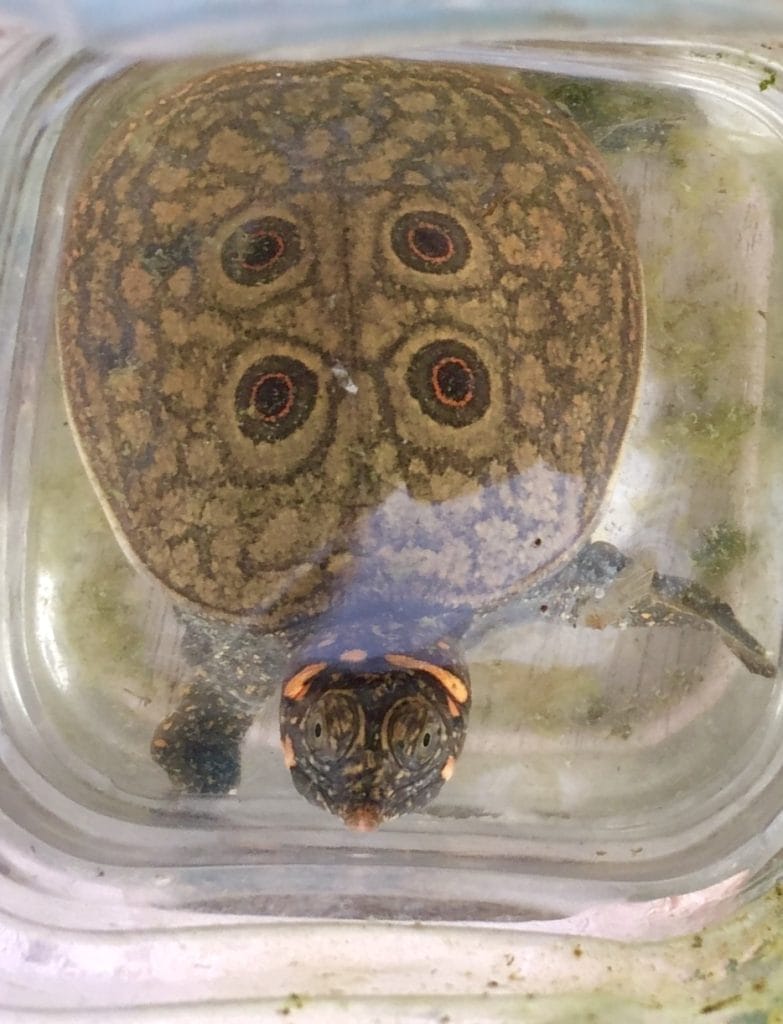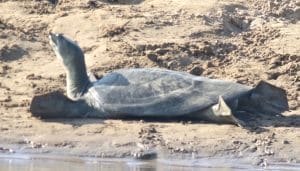Nilssonia formosa (Burmese peacock softshell turtle)
Home > Turtle Database > Nilssonia formosa (Burmese peacock softshell turtle)
Nilssonia formosa, commonly known as the Burmese peacock softshell turtle, is a rare freshwater species found in Southeast Asia. It is known for its striking appearance, featuring a pattern of eye-like spots on its carapace, resembling the feathers of a peacock.
Native To These Regions
MyanmarNative Turtle Species Map – Find Turtles by Region
Scientific Classification
Kingdom: Animalia
Phylum: Chordata
Class: Reptilia
Order: Testudines
Family: Trionychidae
Genus: Nilssonia
Species: Nilssonia formosa
Common Names
Burmese peacock softshell turtle
This Hilarious Turtle Book Might Know Your Pet Better Than You Do
Let’s be real—most turtle care guides feel like reading a textbook written by a sleep-deprived zookeeper.
This one’s not that.
Told from the snarky point of view of a grumpy, judgmental turtle, 21 Turtle Truths You’ll Never Read in a Care Guide is packed with sarcasm, sass, and surprisingly useful insights.
And hey—you don’t have to commit to the whole thing just yet.
Grab 2 free truths from the ebook and get a taste of what your turtle really thinks about your setup, your food choices, and that weird plastic palm tree.
It’s funny, it’s honest, and if you’ve ever owned a turtle who glares at you like you’re the problem—you’ll feel seen.
Identification
Description
This species has a flattened, leathery carapace with a brownish-green coloration. Its most distinctive feature is the series of circular, eye-like markings on the shell, resembling peacock feather patterns. The head is elongated with a tubular snout, allowing it to breathe while mostly submerged.
Sexual Dimorphism
Females grow significantly larger than males, reaching over 60 cm in shell length, while males remain smaller. Males often have longer, thicker tails compared to females.
Check more turtles from the Nilssonia genus
Native Origin and Distribution
Geographical Range
Nilssonia formosa is native to Myanmar, primarily inhabiting freshwater rivers and lakes. Its exact distribution is poorly studied due to its elusive nature and declining population.
Preferred Habitat
This turtle prefers slow-moving or still freshwater bodies, such as large rivers, oxbow lakes, and floodplain areas. It is commonly found in areas with soft, sandy or muddy substrates, where it buries itself for camouflage.
Behavior
Feeding Habits
It is an opportunistic carnivore, feeding on fish, crustaceans, mollusks, and aquatic insects. Occasionally, it may consume plant matter, but its diet is predominantly animal-based.
Predators
Juveniles are vulnerable to predation by birds, large fish, and other reptiles. Adults face fewer natural predators but are heavily hunted by humans for meat and traditional medicine.
Reproduction
Breeding Season
Breeding typically occurs during the dry season when water levels are lower, providing suitable nesting conditions.
Reproductive Method
Females lay eggs in sandy riverbanks, depositing clutches of up to 30 eggs. Hatchlings emerge after an incubation period of 60–90 days, depending on temperature conditions.
Conservation
Extinction Status
Nilssonia formosa is classified as Critically Endangered by the IUCN due to habitat destruction and overexploitation.
Threats
Major threats include habitat loss from dam construction, sand mining, and water pollution. Overharvesting for the illegal pet trade and traditional medicine further endangers the species.
Conservation Measures
Efforts to protect this species include habitat conservation, breeding programs, and legal protection in Myanmar. Conservationists are working to raise awareness and enforce stricter trade regulations.
Economic Importance
This species has been historically hunted for its meat and used in traditional medicine. It is also sometimes sold in the illegal wildlife trade, making it a target for poaching despite legal protections.
Interesting Facts
- The peacock-like spots on its shell provide natural camouflage in murky waters.
- Unlike many other softshell turtles, it is rarely seen basking, spending most of its time buried in sediment.
- Due to its rarity, very little is known about its wild population, making conservation efforts challenging.

About Author
Muntaseer Rahman started keeping pet turtles back in 2013. He also owns the largest Turtle & Tortoise Facebook community in Bangladesh. These days he is mostly active on Facebook.















